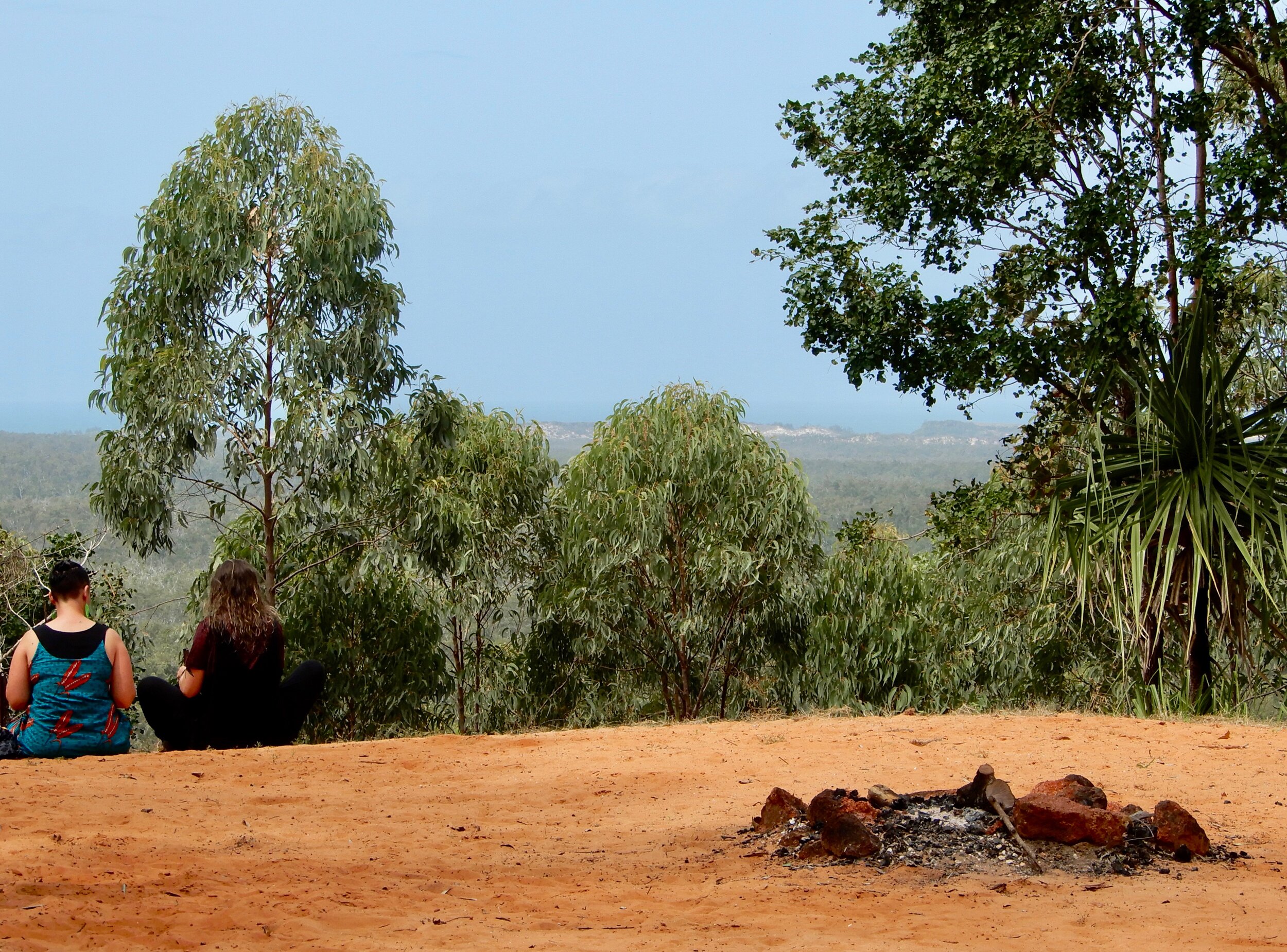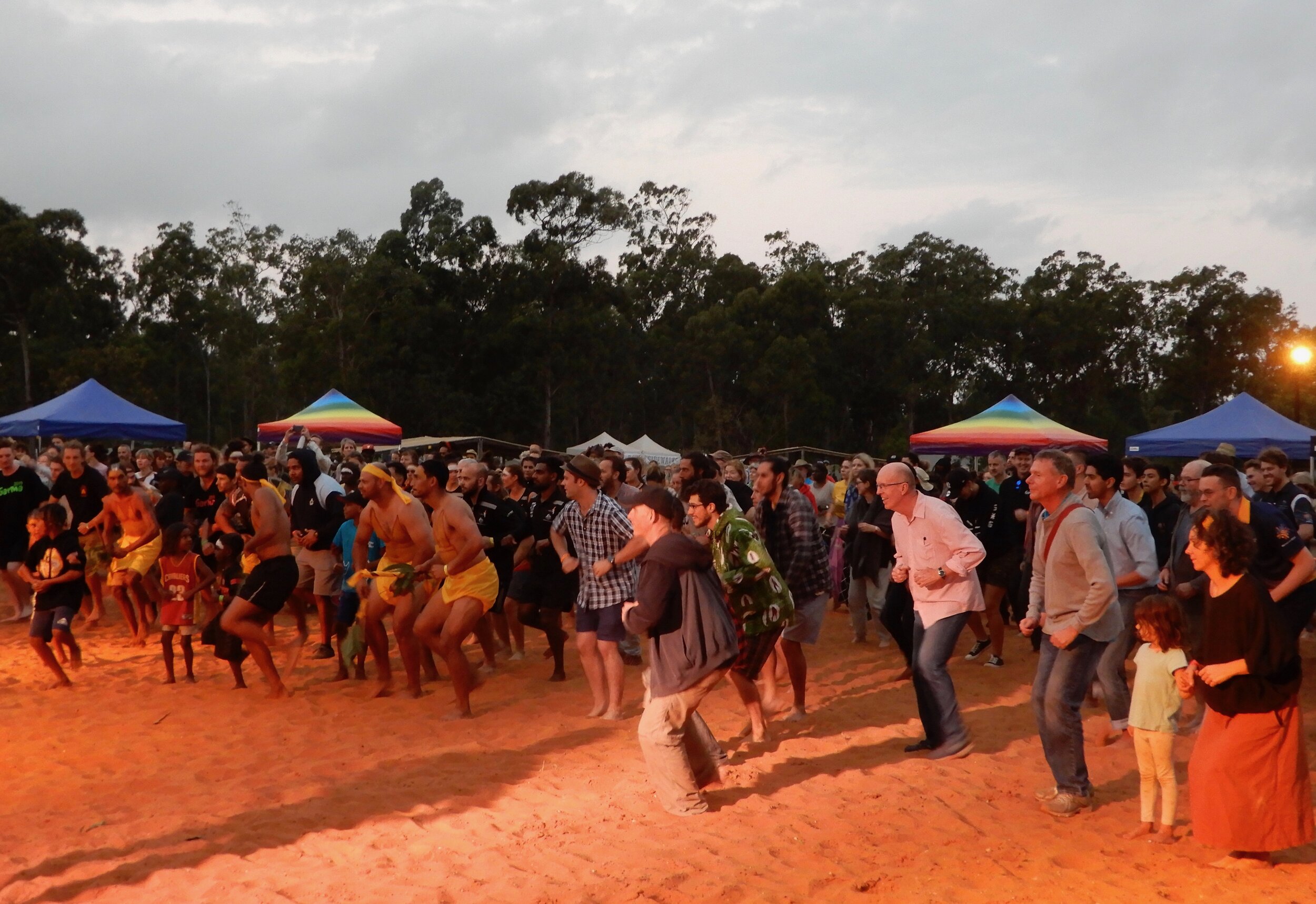East Arnhem Land and Garma
| Planning News December 2019
The Garma Festival in East Arnhem Land, is run by the Yothu Yindi Foundation (YYF) which was established in the 1990s.






At the 2010 festival, the current chair of the foundation, Galarrwuy Yunupingu invited participants to accept the gift of aboriginal difference:
“What Aboriginal people ask is that the modern world now makes the sacrifices necessary to give us a real future. To relax its grip on us. To let us breathe, to let us be free of the determined control exerted on us to make us like you…What a gift this is that we can give you, if you choose to accept us in a meaningful way”.
North East Arnhem Land
Arnhem Land is around 500km from Darwin. (The ‘Arnhem’ was a Dutch ship which sailed along the coast in 1623). The tract of nearly 100,000km² is one of the last strongholds of traditional Aboriginal culture in Australia with a total population of approximately 16,000 people, of whom 12,000 are Aboriginal Yolngu people. Yolgnu have lived here for at least 50,000 years and clans live throughout the region much as they always have, hunting fish, bush animals and seasonal bush foods. English is largely a second language with Yolgnu matha the first language.
North East Arnhem Land (including the Gove Peninsula) is part of the Arnhem Land Aboriginal Land Trust and held under inalienable freehold title by the traditional owners. The township of Nhulunbuy and the associated bauxite mining operation are located on lease areas. The Dhmirru Aboriginal Corporation manages the land and issues permits for access to recreation areas around the peninsula.
Garma
Garma has evolved from a small community gathering in 1999 to a major conference and festival attended by around 2,650 people and sponsored by 21 corporate partners, among them Developing East Arnhem Land Ltd. (DEAL). Participants camp over four days among the Gadayka (stringybarks) on the Dhupuma plateau overlooking Cape Arnhem, 40km south of Nhulunbuy. The site, Gulkula, is a cultural gathering place for the Gumatj clan of north-east Arnhem Land. Volunteers from all over Australia spend two weeks at the site setting up tents and blowing up air mattresses, driving buses to and from the airport and managing the audio visuals and the politicians. The 15 Yolngu tribes who come to Garma from the settlements in East Arnhem Land have their own campsites, grouped by clan, family or gender, and passing on knowledge to the young people is an important part of the festival. This year the theme of the gathering was Pathways to our Future and included a parallel youth forum.
We enjoyed four days of listening, talking, music, women’s healing, spear making, guided bushwalks, astronomy tours, coffee, the library, films, community and corporate stalls and a stunning outdoor art gallery set among the Gadayka and including artists from nearby communities. Sunday was community day with lots of people coming in from settlements. The key forum included speeches and lobbying from politicians, experts and community leaders and we were certainly brought up to date with current Aboriginal affairs and policies. Scott Morrison didn’t attend in 2019 but we were able to get up close and hear Ken Wyatt, Anthony Albanese, Patrick Dodson, Mick Dodson, Linda Burney, Pat Turner, Galurray Yunupingu and Noel Pearson as well as Northern Territory politicians. The 2019 Yolgnu Heroes were the three Ganambarr sisters, Nanbapuy, Merrkiwuy and Ritjilili and Yalmay Yunupingu, all with illustrious records in bilingual and both-ways education and community-building. Each afternoon finished with the bunggul, showcasing the visiting groups’ ceremonial dances.
Pat Turner Lead Convenor - The Coalition of Aboriginal and Torres Strait Islander community-controlled peak organisations (the Coalition of Peaks)
Melbourne University is a principal sponsor of Garma and, in addition to her work on political and legal anthropology and indigenous agreements and engagement with the minerals industry, Associate Provost, Professor Marcia Langton AM, has been an advisor to YYF since 2005. Professor Langton presented the University’s Indigenous Knowledge website, part of the Aboriginal and Torres Strait Islander Curriculum Project. It contains resources for Years 3 – 10 across English, Mathematics, Science, Humanities and Social Sciences, The Arts, Technologies and Health and Physical Education.
https://indigenousknowledge.research.unimelb.edu.au/about
We also heard presentations from Melbourne University staff on two local partnerships; the Master of Teaching clinical practice program in North East Arnhem primary and secondary schools, with the YYF and the NT Education Department, and the Melbourne Dental School partnership with Miwatj Health, establishing a placement program for dental health students implementing an Arnhem Land Oral Health Plan. The University’s association with YYF is a signature program in its Reconciliation Action Plan (RAP).
Superintendent Brendan Muldoon from the Northern Territory police made a presentation on the Aboriginal Recorded Voice Announcement (RVA) system recently set up at 64 police stations across the Territory. Callers hear a recorded message in one of 20 different Aboriginal languages, depending on the location, and can leave a message that can be accessed and responded to. Police can now use email to access voice messages in their particular area. The recorded messages have also reduced the number of regional calls to police that were automatically directed to the Joint Emergency Services Communication Centre (JESCC) through Triple Zero, from the previous level of 4000 calls a month to 1000 calls a month.
One of the projects supported by Developing East Arnhem Land (DEAL) is Manapan Furniture from Milingimbi and Mark White, the director, presented. Milingimbi, a Yolngu settlement of around 1200 people is the largest of the Crocodile Islands west of the Gove Peninsula. Manapan Furniture, has been developing a high-end furniture project for the past two years with the Aboriginal-owned not-for-profit organisation, Arnhem Land Progress Aboriginal Corporation (or ALPA). The enterprise includes a workshop, which is owned by ALPA and operated by Yolngu staff, and training in cabinet-making skills from master craftsmen. The furniture they produce is designed by six leading furniture designers from around Australia and made in the Manapan workshop using Australian timber. Because of the remote location, materials and machinery are brought in on a barge and the furniture is then shipped out to Darwin. This year, DEAL sponsored one of the Yolngu staff, Josiah Baker to attend the Milan Furniture Fair.
https://www.manapanfurniture.com.au/the-design-files-meet-manapan-furniture-makers-in-arnhem-land/
A recent ABC report on the Bawinanga Aboriginal Corporation’s Fishing and Mud-Crabbing enterprise at Maningrida, further along the coast, also highlights the logistics issues faced by remote enterprises trying to work and profit from the available resources. Established in 2016, the Corporation is providing real economic opportunities for traditional owners in the Region. The crew harvest fish and crabs which are sold in Maningrida and surrounding communities and more recently to markets in Darwin, Sydney and Melbourne.
East Arnhem Land
Most of the economic activity on the peninsula is managed by the Gumatj Corporation Ltd which was established in 2007 with a cattle station and a timber mill. Today it employs over 80 people, mostly Yolgnu. Together with the timber mill there is a sustainable timber harvesting business that works off the former Rio Tinto mine site, harvesting timber that would otherwise be destroyed. There are also two subsidiary companies: Gulkular Mining, producing bauxite which it sells to Rio Tinto, and the Mangarr Resource Centre which supports the management of Gumatj Homelands, school attendance and nutrition programs. There is also a nursery located next to the Garma site where local plants for revegetating the former mining areas are grown. There’s also a lot of excitement about a Space Launch Project recently approved by the Gumatj and the Northern Land Council. Equatorial Launch Australia has been granted a 40 year sub-lease from Gumatj for a 60ha parcel of land adjacent to the Garma site.
During the days before and after the festival we explored the beaches to the north and immediate south east of Nhulunbuy, walked around the Nhulunbuy Town Lagoon and visited the gallery in Yirrkala. Our introduction to the area was from a gaggle of school children at the Nhulunbuy look out who filled us in on the history of Rio Tinto and bauxite mining and described their favourite recreation activities around the peninsula. At Catalina Bay we met an Australian Tahitian woman, and her grandson. Lynda had arrived by boat 20 years ago and lived for the first 10 years with her partner on their yacht. Now she leases her house site from the traditional owners and goes fishing with her pet pig every afternoon. (We didn’t ask if the pig was a crocodile decoy but we were certainly very wary on the beaches).
On one of the beaches south of Nhulunbuy we saw a number of stone arrangements made in 1900 to commemorate early trade with Macassans who used to visit Arnhem Land in search of trepang (sea cucumbers). They arrived on the baraa (northwest wind) and returned on the dhimurru (southeast wind) and lived along the coast in stone houses, growing rice, preparing trepang, trading with local communities and taking Yolgnu with them back to Sulawesi. Words such as balanda (whitefella) and rupiah (money) come from Macassan.
While the only settlements we visited were around Nhulunbuy and Yirrkala, we left with a strong impression of the connection between the clans and their land.
At Garma I met and chatted to Johnny Warrkatja Malibirr, an artist from Gapuwiyak who told me about his country and sang his fresh water songline for me. His map of Arnhem Land showed dozens of outlying settlements; small clusters of houses inhabited by one or more family groups.
https://gapuwiyak.com.au/artwork/LBD/1289/
At the most easterly place in the Top End, Buku-Larrnggay Mulka, the gallery at Yirrkala has a predominantly Yolgnu staff of around 20 that services Yirrkala and approximately 25 homeland centres in a radius of 200km. These are the kinds of settlements that “former Prime Minister Tony Abbott targeted with his ‘lifestyle choices’ rhetoric and that former minister Amanda Vanstone dismissed as a ‘cultural museum’.” It’s clear however that in East Arnhem Land, people sustain country and country in turn sustains people.
https://griffithreview.com/articles/caring-for-country-place-where-the-dreaming-changed-shape/





